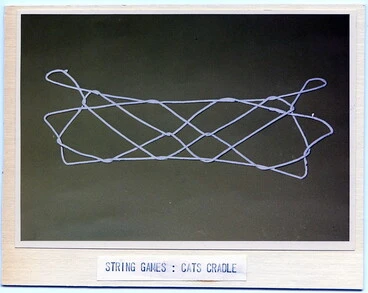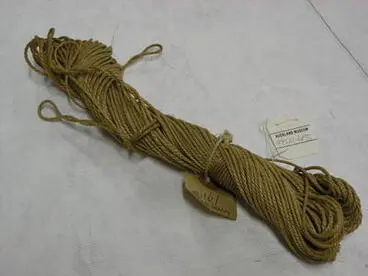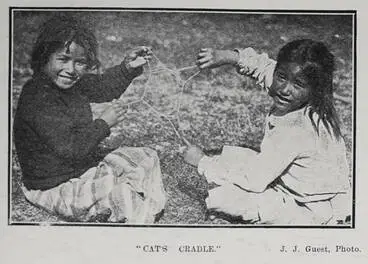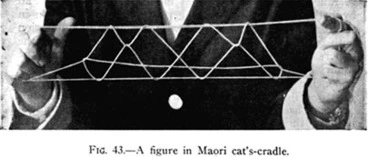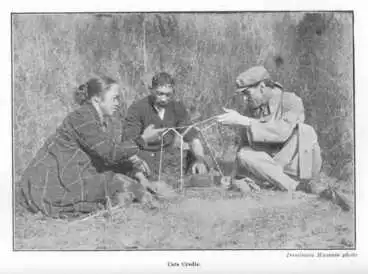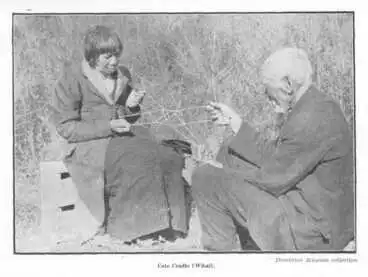Māori string games
A DigitalNZ Story by Zokoroa
Photographs and articles on traditional Māori string games, together with a list of activity suggestions.
Games, String figures, string games, Whai, Cat's cradle, pastimes, Ngai Tuhoe, Māori, Gisborne, Rotorua, Whanganui
This story captures photographs and articles on Māori string games, also known as whai, hūhi, huhu, or māui. Whai is also short for Te Whai Wawewawe a Maui. Suggestions for activities, including videos on making string figures, are also listed.
Maori girls playing a string game
Alexander Turnbull Library
STRing Patterns
The following photos bring back memories of when our mother showed us string figure games that she had learnt as a student at Whangamarino School which overlooks Lake Rotoiti near Rotorua. She began with a length of string, the end of which she tied in a knot to form a circle. When laid across each palm between the thumb and little finger and pulled taut, a rectangular loop formed that created the basic pattern whai (see Diagram: First position). Then she followed the steps in Diagram: Opening A. You can add extra steps to create specific shapes that represent a story, an object or star path. The game can be played solo or with two or more people.
Whai or Maori String Games
Museum of New Zealand Te Papa Tongarewa
Maori games and musical instruments: String game
Archives New Zealand Te Rua Mahara o te Kāwanatanga
Types of materials
Flax (harakeke) was traditionally used for string games. You can also use string, wool, nylon and braid. How long a piece of string? - that will depend on the design. Some games use a two metre length of string (e.g. Cup and saucer), whilst some games need shorter or longer string.
1921: Demonstrating the plaiting & weaving of flax which can be used for string games.
Photograph of a person demonstrating the plaiting and weaving of flax
Alexander Turnbull Library
Pre-1927: String, braided "unbleached mud yarn, 75% riga [hemp], 25% New Zealand flax".
string
Auckland War Memorial Museum Tāmaki Paenga Hira
1921: Group at Koriniti display flaxen items, including whai (woman standing on the right). Photo by James McDonald.
Group of men and women with kete and other items made from flax
Alexander Turnbull Library
Various designs
To get you started on creating various designs, The Ministry of Education's Tāhūrangi - New Zealand Curriculum online for Health and Education lists the following four activities under Whai – String games: Activity Collection:
> Te kapu me te hoiha - Cup and saucer
> Ngā heketau te tauira - Parachute pattern
> Ngā taimana e rua - Two of diamonds
> Tānga mahi whai - Mahi whai relay
For lessons from various cultures, see String Figures and How to Make Them: A study of Cat's Cradle in Many Lands by Caroline Furness Jayne (1906), which has detailed diagrams.
"CAT'S CRADLE." (Otago Daily Times 5-7-1906)
National Library of New Zealand
Patokotoko, or Panokonoko string game
Description of the string game played by Tuhoe and Ngāti Porou.
Victoria University of Wellington
Kura-winiwini string game
Description given of the game and the words recited.
Victoria University of Wellington
Whai or Maori String Games
Museum of New Zealand Te Papa Tongarewa
String games
NZEI Te Riu Roa (New Zealand Educational Institute)
WORDS RECITED DURING STRING GAMES
According to Edward Tregear in The Maori race (1904), "Cat's Cradle” (whai, huhi, or maui) was known to the Maoris as to almost all the inhabitants of the Malay Archipelago and South Seas. It was played with the two hands and a piece of string, assuming very complicated forms; sometimes a whole drama was played by means of the changing shapes. Two of the favourites were the ascent of Tawhaki the Lightning god, to heaven, and the fishing up of the land by the hero Maui. There were proper songs chanted as accompaniments to the movements of the players' hands." (See: NZETC: Edgar Tregear (1904), The Maori race, (Wanganui: Archibald Dudingston Willis, pp.58-59)
1901: Description of popular patterns and the words recited aloud when a pattern was made.
Whai , or Cat's Cradle , Volume 34, 1901, Transactions and Proceedings of the New Zealand Institute 1901
Alexander Turnbull Library
Maori girls playing whai
Museum of New Zealand Te Papa Tongarewa
HistOrical photographs of Traditional DESIGNS
Dominion Museum's ethnographic expeditions, 1919-1923
During 1919-1923, the Dominion Museum in Wellington held four ethnographic expeditions to record the songs and oratory of Māori and to photograph and film aspects of their culture and everyday lives. Visits were made to Gisborne (2–16 April 1919); Rotorua (12 April - 8 May 1920); Whanganui River (17 March - 18 April 1921); and Te Tairāwhiti/East Coast (18 March - 12 April 1923).
Each expedition included the Museum's ethnologist Elsdon Best and photographer/cinematographer James McDonald. Johannes Andersen, Chief Librarian at the Alexander Turnbull Library, was also invited because of his knowledge of music and studies of verse and prose. They were also accompanied to the Whanganui River by Te Rangi Hīroa also known as Te Rangihīroa (Peter Henry Buck) and to Tairāwhiti/East Coast by Te Rangihīroa and Āpirana Ngata. An article about the Gisborne expedition has been written by Natalie Roberston in the Journal of the Polynesian Society (March 2019), which schools can access online via the EPIC database Gale: Global issues in context.
Photographs, films and written accounts of string games were taken by James McDonald and can viewed on Te Papa's website. A special screening of McDonald's films was shown at the Whakaahua Māori Exhibition held in 1986 (see Papers Past: Tu Tangata, no. 28, 1 Feb 1986). You can also see a summary of the scenes McDonald filmed listed on Ngā Taonga Sound & Vision: Gisborne (1919); Rotorua (1920); and Whanganui River (1921).
Dominion Museum's ethnographic expeditions (1919-1923) recorded songs & oratory & filmed aspects of Māori culture & life
Party included James McDonald & ethnologists Elsdon Best, Johannes Andersen, Āpirana Ngata & Te Rangi Hīroa (Peter Buck)
Manatū Taonga, the Ministry for Culture and Heritage
His photographs, films & written accounts of string games can be viewed on Te Papa's website & DigitalNZ
A summary of the scenes McDonald filmed are also listed on Ngā Taonga Sound & Vision:
Museum of New Zealand Te Papa Tongarewa
String Game - Ethnological Expedition
Museum of New Zealand Te Papa Tongarewa
String Game - Ethnological Expedition
Museum of New Zealand Te Papa Tongarewa
String Game - Ethnological Expedition
Museum of New Zealand Te Papa Tongarewa
String Game - Ethnological Expedition
Museum of New Zealand Te Papa Tongarewa
String Game - Ethnological Expedition
Museum of New Zealand Te Papa Tongarewa
Dominion Museum Ethnological Expedition
Museum of New Zealand Te Papa Tongarewa
String Game - Ethnological Expedition
Museum of New Zealand Te Papa Tongarewa
String Game - Ethnological Expedition
Museum of New Zealand Te Papa Tongarewa
String Game - Ethnological Expedition
Museum of New Zealand Te Papa Tongarewa
Photo from ethnographic expedition in 1923 was later published by Elsdon Best in "The Maori As He Was" (1934).
Fig. 43.—A figure in Maori cat's-cradle
Victoria University of Wellington
Other photographers, 1930s & 1940s
You can view historical photographs of Ngāi Tūhoe playing string games at Whakatāne taken by Werner Kissling in 1939 - see British Museum's Online Collection. Photographer H. R. Vine also captured photographs of string games during visits to Northland during the 1930s and 1940s, during which he visited the Kaikohe Native School which had opened on 18 June 1938.
Photographer H.R. Vine documented aspects of Māori life & culture, including string games, during 1930s & 1940s
Image: A group of children holding up a variety of Māori string patterns, possibly at Kaikohe Native School, c.1939.
Alexander Turnbull Library
String figureS studied by Johannes Andersen
Johannes Andersen had been invited to join the Dominion Museum's ethnographic expeditions due to his having written and published poetry and verse. He had also written Māori life in Ao-tea, a compendium of Māori mythology drawn from publications, which was published in 1907. Andersen had been appointed as an assistant in the General Assembly Library in 1915; then became the first Chief Librarian at the Alexander Turnbull Library from 1919-1937.
During the Dominion Museum's four expeditions, Andersen made recordings of Māori music on wax cylinders, including songs sung when string games were played. He also studied the various string figures created and became an expert himself. As he met with different iwi, Andersen came across similar and new forms of string figures, some of which had differing names. He published papers on string games and delivered lectures to various groups.
Source: P. J. Gibbons. 'Andersen, Johannes Carl', Dictionary of New Zealand Biography, first published in 1996. Te Ara - the Encyclopedia of New Zealand, https://teara.govt.nz/en/biographies/3a15/andersen-johannes-carl
Diary kept by Andersen
In the back of Johannes Andersen's diary are research notes on Māori songs, string games, and bird songs.
Alexander Turnbull Library
In-between expeditions, Andersen delivered lectures on similar & new forms of string games he'd seen
(Article: Evening Post (16 July 1919) on Andersen's talk to the Historical Section of Wellington Philosophical Society)
National Library of New Zealand
Evening Post article (28 Oct 1921) on the expedition to Whanganui River, included observing string games
National Library of New Zealand
Women demonstrate string games to Andersen at Jerusalem (Hiruhārama) on the Whanganui River, 1921
Manatū Taonga, the Ministry for Culture and Heritage
Andersen held a speed competition with a Māori woman to make string figures at Whanganui River, 1921
Te Rangi Hīroa (Peter Buck) described the speed competition in his "The Coming of the Maori" (1949).
Victoria University of Wellington
Ethnographic expedition north of Gisborne, 1923
Article mentions string figures and the Cat's cradle.
National Library of New Zealand
Gisborne district, 1923
Article about visiting Gisborne to learn about string games and music, & demonstrations in Wellington by Andersen.
National Library of New Zealand
WriTten accounts of Traditional string games
Various accounts of string games observed during the nineteenth and twentieth centuries can be read online at the New Zealand Electronic Text Centre (NZETC) and by University of Auckland's staff and students at Early New Zealand Books (ENZB).
NZETC
1925: Elsdon Best gives an overview of string games by Māori and other cultures in "Games and pastimes of the Māori".
Victoria University of Wellington
New Zealand Journal of Science and Technology
1926: Johannes Andersen published a series of articles on string figures.
Massey University
NZETC
1930: Popular whai games mentioned by James Cowan in "The Māori: Yesterday and today”.
Victoria University of Wellington
NZETC
1941: Photograph of the Cat's cradle published by Elsdon Best in "The Maori" Vol 2.
Victoria University of Wellington
NZETC
1941: Photograph of woman and man creating a string pattern included in Elsdon Best's "The Maori" Vol 2.
Victoria University of Wellington
Information sharing about string games
Various lectures were held following the ethnographic expeditions, and courses were developed for schools. Here is a sampling:
Y.M.C.A. public lecture with J. C. Andersen, 1924
Lecture held for members and the public.
National Library of New Zealand
Wellington Māori Club activities include string games, 1936
National Library of New Zealand
Dominion Museum lecture for schools, 1937
National Library of New Zealand
Dominion Museum public lecture by W. J. Phillips, 1939
National Library of New Zealand
Feedback on Dominion Museum public lecture, 1939
Letter to the Editor from an appreciative attendee.
National Library of New Zealand
Taranaki Museum course for teachers, 1966
Over 25 teachers from Mokau to Opunake attended a week-long course on Māori life, including making string figures.
Alexander Turnbull Library
RNZ interview (11 Feb 2024): Dr Maureen Lander on 'Aho Marama: Strings of Light' exhibition at Christchurch Art Gallery
The work re-presents digitised Māori string games & conceptual art history of Marcel Duchamp held at Te Papa in 1998
Radio New Zealand
Further Activities
Ministry of Education's Tāhūrangi - New Zealand Curriculum online for Health and Education lists the following four activities under Whai – String games: Activity Collection
TKI Literacy Online: Whai: String games) by Kiwa Hammond (Ready to Read) PDF & Audio
String Figures and How to Make Them: A Study of Cat's Cradle in Many Lands, by Caroline Furness Jayne
A range of YouTube videos are available on string games from around the world, including:
This DigitalNZ story was updated in June 2025
